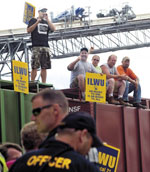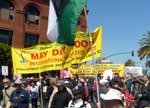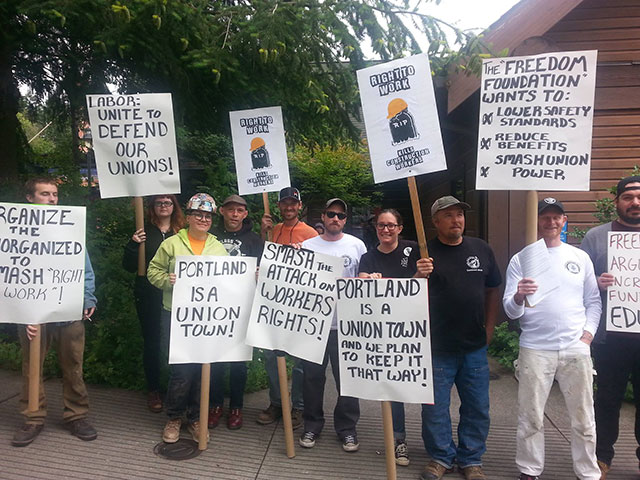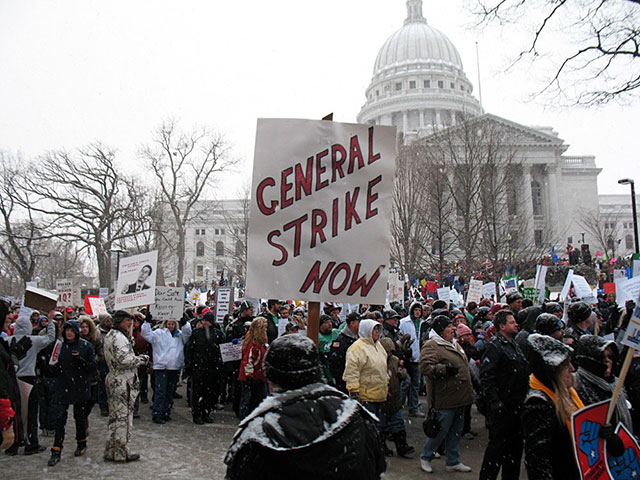
Showdown on West Coast Docks: The Battle of Longview
(November 2011).
click on photo for article

Chicago Plant Occupation Electrifies Labor
(December 2008).
click on photo for article

May Day Strike Against the War Shuts Down
U.S. West Coast Ports
(May 2008)
click on photo for article

July 2018
Supreme Court Seeks to Gut Unions
Life After Janus

Internationalists in march at the AFT convention in Pittsburgh, Pennsylvania, July 7. (Internationalist photo)
Not Democrats or Republicans
But a Workers Party
to Fight for a Workers Government!
A slightly abbreviated version of this article was distributed as an Internationalist Group leaflet at the American Federation of Teachers convention in Pittsburgh, Pennsylvania on July 14.
On June 27, the Supreme Court of the United States issued its long-awaited ruling in the case of Janus v. AFSCME et al. Organized labor and public sector unions in particular have been dreading this moment for several years. The decision, hailed by President Donald Trump as a blow against Democrats, threatens to seriously weaken unions financially by cutting off “agency fees” paid by those who refuse to join the union but still benefit from union-negotiated wage agreements, legal representation against employers and other services. To no one’s surprise, the conservative majority of the black-robed justices decided by 5-4 against the union. This decision will effectively make the entire country “open shop,” and could unleash a union-busting offensive by both public and private sector employers.
 NEW from Class Struggle
Education Workers! 80 pages with articles on the teachers
revolt, Lev Vygotsky, New Orleans schools, Mexican
teachers strike, a special dossier on gentrification and
school segregation, and much more. Price: US$3 (includes
postage). To order, click here.
NEW from Class Struggle
Education Workers! 80 pages with articles on the teachers
revolt, Lev Vygotsky, New Orleans schools, Mexican
teachers strike, a special dossier on gentrification and
school segregation, and much more. Price: US$3 (includes
postage). To order, click here.
Across the country, would-be union-busters celebrated. Nevertheless, unionized workers have the power to make them choke on their cheers. Janus may be a turning point in the class struggle in the United States, but it is far from the death sentence that the present labor leadership fears … and did nothing to stop. What the Supreme Court decision does, in addition to letting non-union members become “free riders,” is effectively eliminate the obligatory dues check-off. This arrangement is the height of class collaboration, giving bosses control over union finances, which they can cripple by holding back the cash. In New York City, the courts canceled the dues check-off after the union leadership caved in and called off the 2005 subway and bus strike. And it was NY Democratic state attorney-general Eliot Spitzer who led the anti-union charge.
Decades of bureaucratic deal-making, capitulations, building illusions in “labor-management cooperation” and support for the Democratic Party have led to this sorry state of affairs. Unions would be far stronger if they collected their dues directly from the membership, and stopped acting like a service provider. But then they would have to do what they should have been doing all along – waging hard class struggle. That includes defying the bosses’ state, and would require raising class consciousness among the members. Behind the decision to eliminate the “agency shop” is a calculation by the ruling class – the bourgeoisie – that they could get away with it without serious blowback from labor. We need to prove them wrong. And to do that, we need to oust the pro-capitalist misleaders of labor who fear and loathe class struggle like the plague.
Already 28 states have “right-to-work” laws outlawing any measure requiring that employees contribute to the unions that represent them. These union-busting laws came out of the Jim Crow segregationist South, the brainchild of a Texas white supremacist who was financed by some of the U.S.’ most powerful capitalists and hobnobbed with fascists.1 Conservatives and a web of ultra-rightist moneybags like the Koch brothers, the American Legislative Exchange Council, the Freedom Foundation in Washington state, the Independence Institute in Colorado, the Uihlen and Bradley family foundations in Wisconsin, the National Right to Work Legal Defense Foundation, the Liberty Justice Center, the Illinois Policy Institute and the State Policy Network have been pushing for years for a court decision to enforce “right-to-slave” nationally.2 The Supremes split 4-4 on the earlier Friedrichs v. California case, due to the sudden death of Antonin Scalia. But after the Republican Congress blocked Obama’s nominee, Trump installed a hard-line defender of corporate interests, Neil Gorsuch, on the court.

Protest in New York City’s Foley Square on June 28 against the Supreme Court ruling in Janus v. AFSCME. (Internationalist photo)
So what did labor do this past year with Janus looming? The bureaucrats acted like it was “game over,” because they so wedded to the “law and order” of American capitalism that they couldn’t even conceive of fighting the Supreme Court.. (In fact, many labor “leaders” are lawyers, including AFL-CIO chief Richard Trumka and American Federation of Teachers president Randi Weingarten.) They called for rallies the day after the decision, making no attempt to mobilize labor’s power beforehand. A February 24 “Working People’s Day of Action” two days before the Supreme Court hearing on Janus was simply a showcase for Democratic phony “friends of labor.” Class-struggle unionists in contrast, have fought the union-busters tooth and nail. In the Pacific Northwest, Wyatt McMinn was arrested in September 2013 for protesting a Freedom Foundation “right-to-work” confab in Vancouver, Washington.3
The anti-union forces targeted government workers (teachers, postal workers, state, county and municipal employees) because they are the one remaining stronghold of organized labor (34% unionized), as unions in the private sector have been decimated (barely 6% of the workforce). So now that “right-to-work” is “the law of the land,” the union tops are scrambling to sign up everyone and sending out teams to talk up the benefits of unions. But mainly, as always, they are looking to the Democrats for salvation. In New York, Democratic governor Andrew Cuomo, after previously championing non-union charter schools and bashing teacher unions, now wants to run for president and needs labor support. So suddenly he is posing as more-liberal-than-thou in his ongoing feud with New York City mayor Bill de Blasio.
On April 12, before a packed house of labor leaders at the United Federation of Teachers headquarters, Cuomo signed legislation to limit the damage the Janus case can do to the unions in New York. It curtails the services the unions must provide free to workers who do not join the union (and don’t pay union dues). As the UFT press release put it, “Outside of the negotiation and enforcement of the collective bargaining agreement, public sector unions will now be allowed to provide legal, economic and job-related services and benefits to members only.” In NYC, where city health insurance is run through the unions, and in union strongholds such as Buffalo and Rochester, the Janus decision may not have an immediately paralyzing effect, though it will certainly bleed the unions financially. Elsewhere it will be devastating.

Union militants picket outside event of the Freedom Foundation meeting pushing for a slave labor “right-to-work” law in Oregon, 24 June 2016. (Photo: Class Struggle Workers – Portland)
After right-wing Wisconsin governor Scott Walker rammed through his bill eliminating collective-bargaining rights for public employees in 2011, public sector union membership in the state was slashed from over 50% to under 25%. At the UFT Delegate Assembly in February, Wisconsin AFT president Kim Kohlhass listed the results: a $5,000 cut in take-home pay as teachers had to pay for health insurance and pensions; loss of prep time and duty-free lunch periods; daily before-school management meetings; and all teachers are now “at-will,” without tenure, so they can be denied a contract for no reason. Meanwhile, state funding for public education was slashed, funds per student for voucher programs are now higher than in public schools, and due to a teacher shortage caused by educators fleeing the state you can get a teaching license before graduating from college.
But what Kohlhass and UFT president Mike Mulgrew didn’t say is that the massive revolt against Walker’s bill by tens of thousands of teachers and other public employees was called off by sellout union leaders. To bust the union-busters, labor must use its power – that is, the unions must be prepared to strike – to walk out and shut it down. Teachers in West Virginia, Kentucky, Arizona and other states did just that this spring. But AFT and NEA leaders are so beholden to the Democrats that they claim that striking is only called for in Republican “red states.” And they hide behind legislation like New York’s Taylor Law which makes it illegal for public employees go on strike. UFT leaders are so terrified of the “s-word” that when a delegate who is a member of Class Struggle Education Workers raised it, they ordered her words stricken from the minutes.
Class struggle unionists stand for a closed shop, where employers must hire union members only, which was banned under the Taft-Hartley Act in 1947 (which also outlawed secondary strikes, and spurred a purge of “reds” from union leaderships). We defend the union shop, where all employees must join the union, which was outlawed by the Supreme Court in 1985. We fight for union hiring halls, such as in West Coast longshore and some construction trades, where the unions dispatch workers. We fight against all anti-labor laws, and union-busting measures such as bans on the agency shop and the dues check-off. But we are not in favor of such practices, which amount to formalized class collaboration between unions and management. The dues check-off was introduced during World War II in exchange for a no-strike pledge by the unions.
The previous Supreme Court ruling overturned by the Janus decision was Abood v. Detroit Board of Education (1977), which institutionalized the agency shop in order to ensure a steady source of income for unions in exchange for “labor peace.” An amicus curiae (friend of the court) brief by AFT president Randi Weingarten in the Janus case upholding Abood is a paean to “Labor-Management Collaboration Made Possible Through Collective Bargaining.” Without that collaboration, it may be “more difficult for a union in this circumstance to decline to pursue marginal grievances” and the “outcome is often a more confrontational, less cooperative relationship,” Weingarten wrote. And if that wasn’t explicit enough, the AFT chief told education writer Valerie Strauss (Washington Post, 5 March):
“The funders backing the Janus case and the Supreme Court Justices who want to eliminate collective bargaining with the hope that such a move would silence workers need only to look at West Virginia for what will happen if they get their way. A loss of collective bargaining would lead to more activism and political action, not less.”

But it takes two to class-collaborate, and as a result of the betrayals by the union misleaders, key sections of the capitalist class figure they don’t need to anymore. They’re going for the jugular. Supreme Court justice Samuel Alito said as much in the majority opinion on Janus: “Whatever may have been the case 41 years ago when Abood was decided, it is thus now undeniable that ‘labor peace’ can readily be achieved through less restrictive means than the assessment of agency fees.” Yet there is ferment among the ranks, and a willingness to fight that hasn’t been seen since the 2011 workers revolt in Wisconsin. The bought-off union bureaucrats (Weingarten makes over half a million dollars a year) may bandy about the spectre of West Virginia, but these “labor fakers” are incapable of waging class war, which is what it will take.
The present U.S. labor bureaucracy was put in place in the anti-Soviet Cold War through a wholesale purge of the “reds” who built the unions. That witch hunt was carried out by liberals and Democrats, not McCarthyite Republicans like Trump. Occasionally, when pushed to the wall, the union tops may give way to real displays of workers power – such as the 2005 New York City transit strike when TWU Local 100 walked out, shutting down the subways and buses in defiance of the Taylor Law.4 Or the labor revolt in Wisconsin in 2011.5 But even when giving into the pressure of the ranks, the pro-capitalist misleaders of labor cannot lead such struggles, at best they tail after them and at the decisive moments stab them in the back. Life after Janus will require hard class struggle, and for that the parasitic bureaucracy must be driven out.
It is crucial to distinguish the unions from the labor bureaucracy, a parasitic petty-bourgeois layer that sits atop these mass workers organizations, seeking to mediate between the working class and the bourgeoisie but ultimately loyal to the ruling class. Those fake-leftists who equate the unions with the bosses become adjuncts to the union-busters. Thus the vile World Socialist Web Site (a/k/a Socialist Equality Party) recently hailed the Supreme Court’s decision in the Janus case as “a defeat for the union bureaucracy, not the workers” (“Supreme Court rules against unions in Janus case,” WSWS, 28 June). Various reformist social democrats, on the other hand, reflexively adopt the attitude of the “progressive” wing of the labor bureaucracy. This is notably the case of Labor Notes, led by supporters of Solidarity.
Its July 2018 issue is a special guide to Rebuilding Power in Open-Shop America. The guide features a six-point “prescription” for “getting back to basics,” including nostrums like “Be Democratic,” “Fight the Boss,” “Turn Up the Heat,” “Ask People to Join,” “Count Noses,” “Don’t Go It Alone.” It has a self-assessment quiz, advice like “Make Meetings Welcoming and Useful,” and other helpful hints for the left-talking bureaucrat who wants to rev up the ranks for a little action. But nowhere does Labor Notes’ guide mention capitalism or capitalists (instead it talks of “the 1%”), no-strike laws, the Democratic Party, the labor bureaucracy and the other enemies and obstacles to be confronted in a knock-down, drag-out labor battle. Its prescription for militant trade-unionism won’t prepare workers for the sharp class struggle ahead.
That was dramatically shown in Wisconsin in 2011. The mass workers revolt arose from the ranks, much like the recent West Virginia strike, as teachers in Madison and then statewide decided to “sick out” in response to Scott Walkers’ draconian anti-union legislation. It quickly mushroomed as tens of thousands marched around the state capitol in the cold, day after day, with over 100,000 on the weekends. The labor action riveted activists around the country. Supporters in Egypt sent pizzas. The Internationalist declared from the outset, in a leaflet, that “It will take nothing less than a statewide general strike to defeat labor hater Walker.” Soon calls for a general strike were everywhere. The Wisconsin South Central Labor Federation (SCLF), led by supporters of Labor Notes, voted to authorize one. It even issued a how-to pamphlet.

Labor bureaucracy’s betrayal of Wisconsin workers’ struggle in March 2011 on eve of a possible general strike led to devastation of the unions. (Photo: Yuri Keegstra )
When D-Day arrived as the Republican governor and legislature passed the bill, the Wisconsin State Journal (10 March 2011) reported, “Thousands Storm Capitol as GOP Takes Action.” Under these circumstances, a general strike wouldn’t be a walk-through like European unions sometimes call. Fearing the explosion that would result, the state AFL-CIO called off the struggle, told workers to go home and instead mount a drive to recall Republican legislators. And for all its militant talk in the preceding days, the Labor Notes leadership of the SCLF caved. It was not prepared to take on the top labor officialdom, the Democratic Party and the capitalist state. And so the struggle went down to defeat.
The Janus decision sharply poses the need for a leadership with a program to play hardball, as the bosses are doing – to fight to win. Class-struggle unionists would call for union dues to be collected by the union itself, at the workplace and on the shop floor. They would call for elected strike committees and delegates that can be recalled at any moment. They would fight to break all ties to the Democrats, Republicans or any capitalist party, and instead to fight to build a class-struggle workers party, as IUPAT (Painters) Local 10 in Portland, Oregon did in 2016.6 And they would prepare to shred anti-labor laws and Supreme Court decisions with massive workers action, on the road to a revolutionary workers government that brings down the rule of capital. ■
- 1. See “It Will Take Hard Class Struggle to Defeat “Right to Work,” The Internationalist No. 48, May-June 2017.
- 2. See “Web of Donors Sees a Chance To Curb Labor,” New York Times, 26 February.
- 3. See “Defend Wyatt McMinn, Defeat ‘Right to Slave’!” The Internationalist No. 36, January-February 2014; and “Wyatt McMinn Not Guilty!” The Internationalist, June 2014.
- 4. See the articles in The Internationalist No. 23, April-May 2006.
- 5. See the articles in The Internationalist No. 33, Summer 2011.
- 6. See “To Hell with the Bosses’ Parties – For a Class-Struggle Workers Party!” The Internationalist No. 45, September-October 2016.